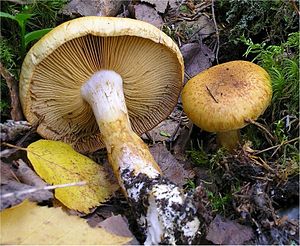Adorned slime head
| Adorned slime head | ||||||||||||
|---|---|---|---|---|---|---|---|---|---|---|---|---|

Decorated mucous head ( Cortinarius saginus ) |
||||||||||||
| Systematics | ||||||||||||
|
||||||||||||
| Scientific name | ||||||||||||
| Cortinarius saginus | ||||||||||||
| ( Fr .: Fr.) Fr. |
The decorated Schleimkopf ( Cortinarius saginus ) is an edible mushroom from the family of the veil relatives (Cortinariaceae).
features
Macroscopic features
The thick-fleshed hat is hemispherical when young, then more flatly arched to spread out. It has a diameter of 5–10 (–13) cm. Its surface, slimy in damp weather and greasy, shiny in dry weather, is colored ocher to rusty yellow. It is ragged or scaly riddled with darker, ocher-brown remnants of an overall envelope ( Velum universale). The edge of the hat, which is covered with remains of velum, remains rolled up or bent downwards for a long time and only fully spreads late in the development of the fruiting body. It is then often irregular and wavy. An initially whitish veil ( Cortina ) is formed on young fruiting bodies . The densely packed lamellae are initially pale cream and turn increasingly rusty brown as the spores ripen. They are straight to slightly downwardly attached to the stem and their edges are slightly notched. The fleshy, fibrous stem is 5–10 (–12) cm high and a good 1–2.5 cm thick. The base of the stem is thickened like a club. Its surface is white, darker in color in the lower part and, especially in the young stage, is belt-shaped with ocher-brown remains of velum. The thick, firm meat has a whitish color, a mild taste and an insignificant odor. The skin of the hat turns golden yellow to yellow-brown when treated with 3% potassium hydroxide solution , the flesh darker.
Microscopic features
The ellipsoidally shaped spores measure 8-10.5 x 5-6 (-8) micrometers and have a warty surface. The cap skin is single-layered (pure epicutis, Pileipellis simplex ).
Species delimitation
A dangerous mix-up would be with the poisonous bright yellow clubfoot ( Cortinarius splendens ) or other poisonous veils. The similar yellow puss in boots ( Cortinarius triumphans ) is somewhat lighter in color and associated with birch trees. The closest relative is the fox slime head ( Cortinarius vulpinus ), which lives in deciduous forests.
ecology
The coniferous forest lives in mycorrhizal symbiosis with spruce. The fungus prefers lime-poor soils. Its massive fruit bodies appear sociable and often a bit tufted between September and October.
distribution
The decorated mucous head occurs in northern climates of the northern hemisphere with a locally frequent occurrence in the hemiboreal to southern boreal zone. Occasionally it occurs in the central boreal zone in forest tundra areas, where it is rarely found. In Central Europe it occurs mainly in higher mountain ranges, but not infrequently also in low mountain ranges and occasionally also below.
meaning
It is edible and is used as an edible mushroom .
Systematics and taxonomy
The species is assigned in the genus of the Schleierlinge ( Cortinarius ) to the subgenus of the Schleimköpfe ( Phlegmacium ).
The official first description comes from the work "Systema mycologicum" by Elias Magnus Fries published in 1821 , in which he already established the taxon Phlegmacium as a tribe of the genus Agaricus and called the species " Agaricus saginus ". In his work "Epicrisis systematis mycologici", published 17 years later, he himself already assigned the current genre.
The species epithet " saginus " from the scientific name is a reference to the "fullness" of its fruiting bodies (Latin " saginare ": "fatten", " saginus ": "thick", "massive"). In older literature there is also the term "Massiger Schleimkopf", which is a direct translation of the scientific name.
swell
- ^ A b Hans E. Laux: The great cosmos mushroom guide. All edible mushrooms with their poisonous doppelgangers. Franckh-Kosmos, Stuttgart 2001, ISBN 3-440-08457-4 , p. 368.
- ↑ Hans E. Laux: Edible mushrooms and their poisonous doppelgangers . Collect mushrooms - the right way. Kosmos Verlags-GmbH, Stuttgart 2005, ISBN 978-3-440-10240-4 , p. 46 .
- ↑ a b c d Fredi Kasparek: Cortinarius saginus . In: Der Tintling: Mushroom Weekly Calendar: 2004 - Schleierlinge . tape 5 , 2003, p. 13 ( tintling.com ).
- ↑ S. Garnica, M. Weiß, B. Oertel, F. Oberwinkler: Phylogenetic relationships of European Phlegmacium species (Cortinarius, Agaricales) . In: The Mycological Society of America (Ed.): Mycologia . tape 95 , no. 6 , 2003, p. 1155-1170 (English, mycologia.org - PMID 21149018 ).
- ^ A b Tobias Frøslev, Thomas Stjernegaard Jeppesen: Cortinarius saginus. In: The Phlegmacium website. Retrieved May 20, 2012 .
- ↑ George Massee: British fungus flora . A classified text-book of mycology. tape 2 . G. Bell & sons, 1893, p. 100 (English).
- ^ A b John Stevenson: Cortinarius-Dacrymyces . In: Hymenomycetes Britannici: British Fungi . tape 2 . William Blackwood and Sons, 1886, p. 6 (English).
- ^ Elias Magnus Fries: Systema mycologicum . sistens fungorum ordines, genera et species, huc usque cognitas, quas ad normam methodi naturalis determinavit, disposvit atque descripsit. 1st edition. tape 1 . Sumtibus Ernesti Mauritii, Greifswald 1821, p. 226 (Latin, archive.org ).
- ^ Elias Magnus Fries: Epicrisis systematis mycologici . seu synopsis hymenomycetum. Typographia Academica, Upsala 1838, ISBN 978-81-211-0035-9 , pp. 260 (Latin, google.com ).